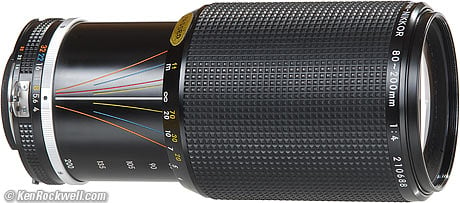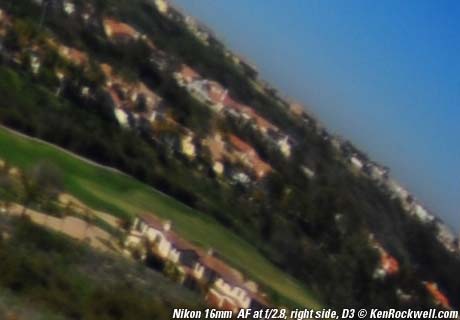Nikon FX Lens Suggestions
© 2008 KenRockwell.com. All rights reserved.
The Nikon D3 with 50mm f/1.4 AF-D. enlarge. I got mine from Ritz. Just as well I'd get another from Adorama, Amazon or B&H Photo Video. It helps me keep adding to this site when you use these links to get yours, thanks! Ken.
January 2008 Nikon D3 Review More Nikon Reviews
New: The Nikon FX Dream Team (Nikon's very best) December 2009
Nikon D700, D3 and D3X lenses May 2009.
Nikon Cheapskate Lenses 13 August 2008
The DX Dream Team: Lenses for DX cameras, only.
|
I buy only from these approved sources. I can't vouch for ads below. |
Introduction
As if you haven't gathered, I've been a sucker for Nikon lenses since I was kid.
I'm tickled silly that the D3 is compatible with everything Nikon's made since 1977, and with some machine-shop hacking, just about everything made since 1959.
The D3 works great with just about every auto and manual focus lens made since 1977. Everything that was old and crappy is new again, since they almost all work on the D3.
For details of what works on your D3, see my Mother of All Nikon Lens Compatibility Charts.
Of course very few cheapskates buy D3s, but I'll cover cheapskate lenses, too. Some of my old cheap lenses are very good thanks to the The Full-Frame Advantage.
DX Lenses
DX lenses work great on your D3, but waste the whole point of the big sensor of the D3.
Used on a D3, DX lenses only use the central 5MP portion of the sensor. A D300 or even a D40 gives more resolution with DX lenses.
If you have DX lenses, donate them to a student with a DX camera. DX lenses waste the full-frame sensor for which you're paying big bucks in a D3.
Suggestions
Here are my suggestions, segregated by budget and application.
Player back to top
Nikon wants the rich guys to drop another five grand on Nikon's big three expensive zooms. This is the easy part and not why you're reading this article. Nikon loves players: the people who buy whatever comes out. See also Is It Worth It?
Except for the 70-200mm VR, these other two lenses are as new as the D3. For you folks playing into Nikon's program, you'll want the:
14 - 24mm f/2.8, the 24-70mm f/2.8 and the 70 - 200mm f/2.8 VR.
While you're at it, throw in the Nikon 16mm f/2.8 AF Fisheye, a 105mm VR macro (I prefer the 200mm AF micro), the $5,100 200-400mm f/4 for your kid's soccer and the new $9,500 600mm f/4 VR for birds, surfing, sports and nature. Honestly, if you have the cash, you'll love all these.
Shooter back to top
For most people buying a D3, I'd get the Nikon 17-35mm f/2.8 AF-S, the 50mm f/1.4 and 70 - 200mm f/2.8 VR and be done. You can skip the midrange 24-70mm zoom unless your bread and butter is weddings; the 50/1.4 is smaller, lighter and much faster. Pros don't use midrange zooms.
Want to shoot in low or no light? The 50mm f/1.4 AF-D works incredibly well, with four times the light gathering ability of any f/2.8 zoom.
If you want a midrange pro zoom, the 35-70mm f/2.8 D is excellent. Its much smaller than either the 28-70mm f/2.8 AFS or 24-70mm AFS, and it sells brand-new on closeout for $480. Get one while you still can; the 35-70mm sold for $700 for most of it's life. I prefer the 35-70mm if I'm carrying it on my D3 around my neck.
I own the huge 24-70 AFS, but it's too big for wanting to walk with it around my neck on a D3. I tried my 24-120 VR, but it wasn't fast enough (f/3.5 - 5.6) for photographing moving people in available light. My 35-70mm f/2.8 AF-D seems to make the most sense. The 35-70mm is small enough to want to carry around all day, it's fast enough for dim light, the optics are as good as the other pro f/2.8 zooms (comparison coming), and you can get a new 35-70mm for about $480 brand-new. It used to sell for $700 in the 1990s.
Even lighter, the 24-85mm f/3.5-4.5 AF-S is also very sharp and inexpensive, but with more straight-line distortion than any of the f/2.8 zooms.
Get the 80-400mm VR instead of the 70-200mm VR for landscape work. The 80-400 VR has much slower autofocus and is two stops slower making it iffy for sports, especially indoors, but I prefer the longer zoom range, smaller size and lighter weight of the 80-400mm.
You have a lot of excellent tele options to save money if you can do without VR. The 80-200mm f/2.8 AF-D and older 80-200mm AF-S are excellent, but lack VR.
The Nikon 17-35mm f/2.8 AF-S is a much more practical choice for most people than the new 14-24mm. The 14-24mm goes insanely wide, but is a huge lens almost 4" in diameter and cannot use filters over the front to protect the very expensive glass.
Not only are filters important for protection, but also important for nature and landscape photography since some filters are best used while shooting, not later. ND grads can't be replicated easily after capture, since the whole point of an ND grad is to bring the subject luminance range into the range of the camera. You'll need a huge sheet of grad ND to hold in front of the 14-24mm, which would still pick up reflections of what's behind and above you from the filter glass. With my 17-35mm, I use a 77mm screw-in Tiffen ND 0.6 and I'm done, and there's no chance of embarrassing reflections.
I love my 17-35mm because it takes normal 77mm screw-in filters and weighs 9 ounces (250g) less than the beastly 14-24mm f/2.8. Most people will find the 17-35mm focal length range more useful than the insanely wide 14mm end of the 14-24mm.
If you don't mind a plastic-barreled lens on your D3 and a little more barrel distortion; the 18-35mm AF-D is as sharp as the 17-35mm AFS!
Casual Wandering Around
So long as you have enough self-confidence to use a $100 (used) lens on your new $5,000 camera, the D3 works fantastically well with Nikon's most recent inexpensive film lenses: the discontinued 28-80G and the discontinued 28-200G.
Both of these ultra-lightweight plastic-mount lenses use every optical trick Nikon has learned in 90 years. These cheap lenses perform remarkably well.
The cheapest 28-80G focuses faster, focuses more closely and is easier to zoom quickly than any professional normal zoom.
The ultra-close focus of each of these two lenses make them more flexible for general carrying around than pro lenses. Honestly, what pro 80-200mm can focus to 17 inches (0.44m) at 200mm as does the 28-200G? I've photographed my kid a few feet away at the 135mm setting of the 28-200G, while no pro tele focuses that close.
I usually grab the 28-200mm G for its larger zoom range, although its autofocus is much slower. The 28-80G has instant AF and much less distortion.
Not only are these plastic G lenses much better than you think, but also the D3 has the full-frame advantage in its favor with them. The D3's low linear pixel density, lower than any other Nikon except the original 3MP D1 models and 4MP D2H models, isn't as picky as more recent DX cameras about lens resolution.
I get remarkable results with these dinky lenses, which actually are much better than earlier and more expensive lenses when I tote my D3 with me everywhere I go and demand light weight for fooling around.
Sure, for serious walking around I use the 50mm f/1.4 D (night time) or 35-70mm f/2.8D, but for just running out for lunch in the daytime, these plastic G lenses work far better than you'd ever imagine.
Avoid picking up the D3 by grabbing one of these plastic lenses, since you might break the plastic mount and drop your D3!
Macro
I say macro. Nikon says micro. I use these phrases interchangeably and we each mean the same thing.
The 105mm macro lenses are the most versatile, and not much more expensive than the 55mm and 60mm micros.
I prefer my older 105mm f/2.8 AF macro. The few new 105mm VR macros I've tried didn't focus well with my D200. When I shoot a macro lens, it's usually manual focus with strobes, so VR and even AF are irrelevant. If you're a cheapskate, a manual focus 105mm is also excellent.
The 60mm AF macro works great, but you usually have to get too close to your subjects. You annoy living things, and make lighting cramped for any subject. The 60mm was ideal for copying documents, but today, any $50 flatbed scanner is far better than a D3.
The 200mm AF macro is extraordinary. It's among the sharpest lenses on the planet; as sharp at f/4 as any other aperture. Long macros are used by serious macro people because you can stand far enough away not to annoy bugs, not get in the way of your lighting and get a much more natural perspective for product shots. The 200mm AF micro is also Nikon's sharpest 200mm lens, better than any of the zooms or the old manual-focus 200mm micro.
The 70-180mm Micro is also good, but expensive and harder to find.
Fisheye
This is easy: get the 16mm f/2.8 AF-D fisheye. It works great, as expected. It's soft in the corners wide open, but stop down and it's fine. Use f/11 for optimum corner sharpness if you're looking at 100%. The 1970s 16mm f/3.5 manual focus also works great (review coming). Its a tiny bit sharper at large apertures, but has a little lateral color fringing which the AF-D doesn't, so use whichever you can. They are almost identical in optical quality. The difference between 170 degrees (16mm f/3.5) and 180 degrees (all other 16mm f/2.8) is almost invisible in comparison.
The DX 10.5mm works fine, but wastes the whole point of the bigger FX sensor.
The manual focus 16mm f/2.8 hasn't performed as well for me, but costs less and is perfectly compatible with the meter of the D3. So are any of the older 16mm f/3.5 AI lenses which I've never tried.
If you find an old AI or AI-s 8mm or 6mm, go right ahead. These will give you a circle in the middle.
Ultra-Ultra Wide (13mm, 14mm and 15mm)
Of course try the new 14-24mm zoom if you can handle it. It sets new world's records for ultrawide optical performance, especially if you're looking in the corners at large apertures. The 14-24mm is about as sharp at 14mm and f/2.8 as the fixed 14mm at f/5.6! The zoom also has much less corner darkening at f/2.8 than the fixed lens.
The excellent fixed-focal-length 14mm f/2.8 AF is much smaller and lighter than the gigantic 14-24mm zoom. The 14mm fixed lens isn't as sharp at f/2.8, but stop it down and it's just about the same.
The fixed 14mm has less, but weirder, distortion than the zoom. The zoom's distortion is very simple and easy to correct in Photoshop.
The 14-24mm zoom is excellent, but too darn huge. The fixed 14mm f/2.8 weighs 12 ounces (333g) less than the zoom!
Nikon's Holy Grail, the built-to-order and no longer obtainable manual-focus 13mm f/5.6, works great. Oddly the automatic lateral color fringe correction of the D3 sometimes works and sometimes doesn't, but oddly this 13mm lens has much less straight-line distortion than either the 14mm f/2.8 AF or 14-24mm. The 13mm does have some ghosts, but it's sharp and lacks distortion. If you have one, use it.
The far more practical (and more available) manual-focus 15mm f/3.5 AI-s works very well, if you can work around its horrendous ghosts. The 15mm is very sharp and also has the same astounding lack of straight-line distortion as the 13mm.
Shoot with the 15mm or 13mm and you don't have to bother correcting the distortion later. With the 14-24mm you easily can do it in Photoshop; the fixed 14mm has complex distortion which will require a more advanced tool, like DxO, if they support it for the D3.
The fixed 14mm is a hair wider than the 14-24mm set to 14mm. The 15mm is the least wide, and of course the 13mm is widest. There isn't that much difference among them in field of view; the difference is in distortion and ghosts.
Low Light
The D3 does great at high ISOs.
The 50mm f/1.4 AF and 50mm f/1.8 AF-D are classics. I can shoot just about anything hand-held at ISO 6,400 and f/1.4.
Don't forget the excellent 35mm f/2.0 AF-D. I've always preferred the field of view of 35mm vs. 50mm lenses.
I'm very lucky to have gotten a 28mm f/1.4 AF back when they sold used for only three digits. The 28mm f/1.4 is a spectacular lens, but will run you three Gs used today. That's too bad, because it is the lens to get for low-light. The shorter focal length lets me shoot another stop slower than a 50mm lens hand-held. I shot ISO 50 Velvia hand-held at night at f/1.4 at an eighth of a second and got consistently great shots.
Both the 85mm f/1.8 AF and 85mm f/1.4 AF are excellent. The 85mm f/1.4 is what's on the shot of the D3 above. The f/1.4 is much more expensive than the f/1.8 for only adding 2/3 of a stop; if budget is a concern, you'll love the f/1.8 version.
Nikon's fastest current lens is the manual focus 50mm f/1.2 AI-s. The much more expensive aspherical 58mm f/1.2 NOCT was better wide-open, but no longer made. The regular 50mm f/1.2 is at its best advantage at f/2.
Unlike Canon, Nikon has next to nothing in the fast (f/1.4 and faster) lens department. Canon makes a modern 24mm f/1.4, 35mm f/1.4, 50mm f/1.2 and 85mm f/1.2, all with the most recent AF-S and aspherical technology. Nikon's lenses above are all the old style AF that requires moving a switch to get to and from manual focus, and all Nikon's fast lenses are the old spherical designs that lose contrast wide open from spherical aberration.
You can get a Canon 5D full frame body and one or two of the above lenses for the same price as a D3 body alone. Of course the 5D is an amateur-build camera, not a pro camera like the D3.
Cheapskates
You are the folks who sold your wives on the D3 because it works great with cheap used lenses.
A tiny, but very good and versatile, midrange zoom is the 1990s 28-70mm f/3.5-4.5 AF-D. It will set you back about $70, used. Also try the 28-105mm AF-D. If you have the need for speed, used a fixed lens mentioned above or try the 35-70mm f/2.8 AF.
For $100 new, the plastic 28-80 G works amazingly well.
For tele, try the original 1986 70-210mm f/4 AF constant aperture lens. I paid $130 for mine, used, some years ago. The 70-210mm f/4-5.6 AF-D is excellent, but its used price peaked to something insane and I'm unsure if it ever came back to rationality. The unique advantage of the 70-210mm f/4-5.6 AF-D is that it has the fastest AF this side of the newest f/2.8 pro tele zooms.
For wide and ultrawide, get the 18-35mm AF zoom or a 20mm f/2.8 AF.
Of course cheaper still is to use:
Manual Focus Lenses
Manual focus AI-s, AI and AI-converted lenses work great in manual and aperture-preferred modes on the D3. Anything not AI is too much of a pain since it probably won't mount.
If you tell the D3 what lens you're using, you'll get color matrix metering and record EXIF exposure and lens data. Yay!
The beauty of manual lenses is small size and precise focusing for still subjects. Small size isn't that big a deal on the D3, but here's what I use if anyone asks.
For small size, I use the Nikon 20mm f/3.5 AI, Nikon 28mm f/2.8 AI-s, (use the normal lens of your choice; I recently got a brand-new 50mm f/1.2 AI-s), 85mm f/2 AI-s, 135mm f/3.5 AI and 200mm f/4 AI. I also just collected a Nikon 80-200mm f/4 AI-s, Nikon 80-200mm f/4.5 AI and a 100-300mm f/5.6 AI-s, all of which seem excellent. The 18mm f/3.5 AI-s is also excellent on the D3.
Preliminary D3 Len Tests
Here is raw data which I eventually be be moving to each lens' individual page.
Nikon 135mm f/2.8 Series E: Yikes, this is a very, very sharp lens on the D3, even at f/2.8.
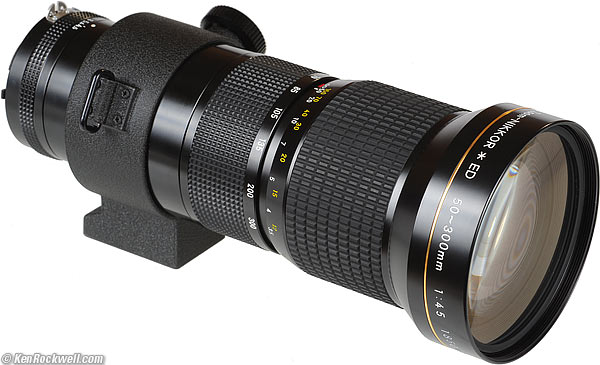
Nikon 50-300mm f/4.5 ED.
The 50-300mm f/4.5 ED works great on the D3, unlike the older non-ED version, which sucks. I thought the 70-300mm VR would easily outdo it, but now it's going to be a close race some day in the future to compare them.

Nikon 85mm f/1.8 (AI updated).
85mm f/1.8 (manual focus) on D3: People go on and on about this lens, and maybe it was hot stuff back in the 1970s on film, but it's nothing special and not better than the 85mm f/1.8 AF on the D3 today.
This old lens never shipped as an AI lens, so it's useless on most cameras today unless you've had it updated to AI somewhere along the way.
I'll compare them, but the newer 85mm f/2 AI-s seems to be Nikon's best 85mm, at least on my D3, even sharper than the 85mm f/1.4 AF.
Oddly, the old manual focus 85mm f/1.8 sells used for about what the AF version sells for new! This old 85mm f/1.8 is very sharp by f/4, but not that exciting wide open in the corners. It's decent enough in the center, but heck, Distortion is negligible pincushion (corrects at 10' (3m) with -0.5 in PS CS2) and bokeh is poor. Only slightly related to bokeh, the manual focus 85mm f/1.8 has only a primitive six-bladed diaphragm while the AF version has a splendid 9-bladed diaphragm.
D3 Long Zoom Lens Comparison: Comparing the Nikon 70-300mm VR, 80-400mm VR, 75-300mm AF and 100-300mm f/5.6 AI-s, they are pretty much the same sharpness-wise. There is often more variation from one corner to the next in the same lens than there is from lens-to-lens.
That caveat offered, at 100mm it's too close to call. At 300mm, the 80-400mm VR is the best, followed by the other three.
What does this tell us? Easy: for action, get the fast-focusing 70-300mm VR, and for careful landscapes, get the 80-400VR for its slight sharpness edge at the long end and extended range. Don't lose any sleep over this, even the older lenses are fine if you have one. Just don't use the old 50-300mm – it sucks.
Nikon 70-300mm VR: Sharpness is pretty good, just a little better than the 40-year old 105mm f/2.5 NIKKOR-P below. It's sharp at all settings, except a little softer in the corners wide-open at 70mm. The distortion is typical for a 4x tele zoom.
Nikkor-P 105mm f/2.5 (Earliest 5-element, 3-group version from 1959-1971): No distortion, easy 1-finger focus, much shorter and lighter than the current 105mm f/2.5 (1971-2005) lenses. My sample is softer on the right side at large (f/2.5) apertures. Close focus: 4 feet/1.2m.
300mm f/4.5 NIKKOR-H versus 300mm f/2.8 ED-IF AI on D3: As I suspected, they are just as sharp. The NIKKOR-H is single-coated in amber, so color balance is slightly cooler than modern lenses like the multicoated f/2.8 ED. On the D3, which corrects any lateral color, they are just as sharp; one's ability to focus is more significant than any difference between lenses.
300mm f/4.5 NIKKOR-H on D3: Wonderful! Even this old lens, made from 1969 - 1974, works great on the D3. It's sharp corner-to-corner wide open; sharp enough that in D3 images I can read large street signs 3/4 mile away and see the positions of the wings of birds flying in flocks 2 miles away! (Warning: the older and identical-looking 300mm f/4.5 NIKKOR-P sucks. The only way to tell them apart, besides the horrendous lateral color fringing of the -P, is to read the lens barrel.)
It's easy to focus and has no lateral color fringes. Bokeh is nicer than most Nikkor lenses, however there can be colored fringes on the outsides of out-of-focus highlights: green behind the subject, and magenta in front of the subject. Distortion is invisible without instruments; use -0.5 to correct in PS CS2's lens distortion filter at infinity and -0.2 at 15 feet (5m). Falloff (darker corners) are only very mild wide open, and gone by f/5.6.
The built-in tripod sockets are perfectly balanced for the D3, but unless you have a 'pod with a small head, the D3's battery bulge will probably bang into your 'pod head. No problem; I did the nasty and put the D3 on a tripod directly.
Considering that the image quality of this 1971 lens, with the automatic lateral color fringe correction of the D3 (and D300), is about the same as the 300mm f/2.8 models, these are bargains at about $100 used! Be sure that any lens you get has been updated to AI; as originally shipped, the 300mm NIKKOR-H lenses won't mount properly on modern cameras.
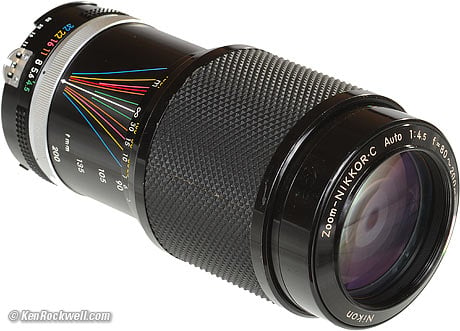
1974 Nikkor-C 80-200mm f/4.5
The 1973-1975 80-200mm f/4.5 Nikkor-C is excellent, sharp from corner-to-corner at every aperture with no lateral color fringes on the D3, as expected, just like the newest 80-200mm lenses. The funny part is how cheaply you can pick these up today, since these are among Nikon's sharpest lenses.
Distortion is reasonable. Plug these figures into Photoshop CS2's lens distortion filter to correct the distortion. .
FX at infinity |
FX at 100' (30m) |
DX at infinity |
|
80mm |
+2.5 |
||
105mm |
+0.1 |
||
135mm |
-0.4 |
||
200mm |
-1.7 |
© 2008 KenRockwell.com
Of course the Prince of Nikon's tele zooms is the 80-200mm f/4 AI-s. It's the sharpest, closest focusing, has a 9-blade diaphragm, and is the best of the best manual focus tele zooms. It beats me why these are so cheap today. You have to work hard to pay more than $100 for threse second hand; they are the deal of deals.
This f/4 is the Prince; the King is the f/2.8 AI-s manual focus, which costs ten times as much used, and does pretty much the same thing.
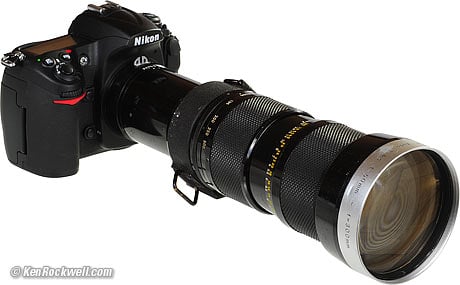
1968 Nikon 50-300mm f/4.5 on a D300.
The 50-300 f/4.5 F from 1968 is awful on the D3. (I only used my D300 as a model for scale.) The 50-300mm is OK at middle apertures at middle focal lengths, but awful in the sides and corners at 50mm and awful everywhere at 300mm. At 105mm and 135mm at f/11 it works very well. At 300mm, there are more lateral color fringes than at a Pride parade. Heaven only knows why they are worth as much as the $200 people typically pay for them, considering how far better any of the Nikkor 80-200mm lenses are for about $50- 100 used. The 50-300mm lenses were scalding expensive in 1968, about half as much as a new Corvette.
Distortion is as hefty as the 50-300mm. Here are the figures to plug into Photoshop CS2's lens distortion filter to correct the distortion.
FX at infinity |
FX at 100' (30m) |
DX at infinity |
|
50mm |
+4.7 |
||
85mm |
-2.0 |
||
105mm |
-3.0 |
||
135mm |
-3.4 |
||
200mm |
-4.0 |
||
300mm |
-5.0 |
© 2008 KenRockwell.com
I rounded up and compared all known Nikkor 20mm lenses, fixed and zoom, auto and manual focus on the D3 and D300 (big report coming). There are nine different ones. They all were about the same in sharpness, from 1967's 20mm f/3.5 UD through the current 17-35mm AFS. The only lens that stood out is the 14-24mm AFS, which is clearly much sharper and has far less darkening in the corners. All were about the same at f/11; the differences are only visible in the full-frame corners at large (f/2.8) apertures. Moral: run what you brung; the results are the same.
The 16mm f/2.8 AI-s fisheye is clearly inferior (softer at the sides at larger apertures) to the modern AF 16mm fisheye, at least between the two samples I tried. They are different designs.
The oldest 16mm f/3.5 fisheye works a little better than the AF version, meaning skip the AI-s if you can.
Roll mouse over to see crops from right sides of 100% images.
Fisheye Shootout: On full-frame, I shot three different 16mm Nikon fisheye designs on the D3 against the Canon 15mm on the 5D.
I shot the current Nikon AF-D 16mm f/2.8 fisheye, older AI-s 16mm f/2.8 and oldest 16mm f/3.5 on the Nikon D3.
On the 5D, I shot Canon's current 15mm f/2.8 EF.
The Nikon 16mm f/2.8 AI-s is clearly inferior to all others. It's softer at the sides at larger and middle apertures. It's fine for most uses, but if you like to waste time splitting pixels, it sucks hard.
The oldest 16mm f/3.5 is the best on Nikon. The current Nikon AF-D 16mm f/2.8 AI-s is almost as good at smaller apertures.
Sorry, Nikon fans: the least expensive lens on the least expensive camera is clearly superior. The images from my 5D and Canon EF 15mm f/2.8 are worlds, no, universeses, sharper at the largest apertures. The 5D is always sharper in the center due to the 5D simply being sharper than the Nikon D3, while the corners at f/2.8 are very soft in the Nikon and worlds sharper in the 5D.
Of course an intelligent person won't shoot at f/2.8 in daylight, but if you must, the Canon is far superior to Nikon.
The illustration shows the vast difference at f/2.8 between the D3 and 16mm AF, and the 5D and 15mm EF. The Nikon 16mm f/3.5 was a little better and the 16mm AI-s was far, far worse, but the Canon easily beat them all. The Canon was superior even at normal apertures.
At least the colors from the D3, at VIVID and +3 Saturation, are slightly wilder than the Canon at +4 Saturation.
The manual-focus 28-50mm f/3.5 AI-s feels great on the D3. It's moderately soft in the corners wide open, and really sharp in the center and stopped down to f/11. There is no distortion at 50mm and in the great macro range, and moderate barrel distortion at 28mm. It focuses, zooms and handles really well on the D3. Resistance to flare and ghosting is excellent, and colors and images look great.
The 35mm f/2.5 Series E (manual focus) feels a bit dinky, as if it's got plastic focus helicoids (it just might.) It's a little too small to feel perfect. It has very little distortion. It has a little bit of ghosting. It's got slightly low resolution but great contrast wide open, and looks decent stopped down. At today's give-away prices, I'd get the far superior 35mm f/2.8 Nikkor AI instead.
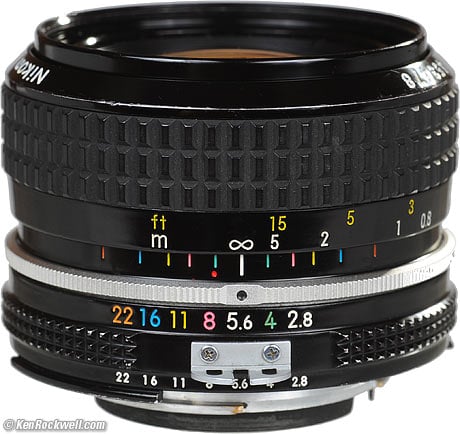
The Nikkor 28mm f/2.8 AI is really good, one of Nikon's best. I'll compare it to the newer 28mm f/2.8 AI-s later, but for now, this older 7-element design (1974-1981) is far better than any third-party 28mm lens, probably second only to the 28mm f/1.4 AF-D and 28mm f/2.8 AI-s. This old AI lens has no distortion at any distance, possible better than the AI-s at close range, and the AI has very little light falloff, even at f/2.8. Flare isn't so great, but then again, my sample has a smashed filter ring and marks on the glass! Even my smashed one has the most perfect focus feel ever - a flick of a fingertip is all you need for perfect, play-free focus. If you can find a bargain on this AI lens, and I know you can, go for it.
Nikon Tele Zoom Observation: I just ran the distortion signatures of the hulking 80-200mm f/2.8 AI-s (review coming), 80-200mm f/4.5 AI (review coming), 80-200mm f/4 AI-s (review coming), 80-400mm VR (review a little updated for the D3) and 80-200mm f/2.8 AF-S (review a little updated for the D3) through the cranker, and lo and behold, they all have almost identical distortion at each focal length! They run from about +3.5 barrel at 80mm to -1.2 pincushion at 200mm, and all match at each setting. Weird, but so much for trying to find a distortion King.
180mm AF on D3: Guess what? The crappy old original 180mm AF from the 1980s, the one with the plastic barrel and thin plastic manual focus ring often available used for just a couple of hundred dollars, works absolutely great. It's got the same optics and autofocus internals as the current tough-looking crinkle-painted metal-barreled 180mm AF-D that sells for about $750.
300mm f/4.5 ED-IF (AI-s manual focus) on D3: Works great! The focus is so fast you need to be careful and pay rapt attention to the D3's three-segment manual focus indicator to get precise focus. If you do, the 300mm f/4.5 ED-IF is sharp and devoid of lateral color fringes even wide open at f/4.5.
Manual 135mm Shoot-out on D3: The 135mm f/2.0 AF DC is obviously sharper at f/2.0 than the 135mm f/2.0 AI-s (manual focus). At f/2.8, the 135mm DC wins, the 135/2 AI-s is next and the 135 f/2.8 Nikkor AI-s is last (but close the the 135 f/2 AI-s). At f/4, I also included the 135mm f/3.5 AI-s, and lo and behold, the 135mm DC is first, but the 135mm f/3.5 AI-s is a close second. At f/4, the 135mm f/2 AI-s has lateral color, while the 135mm f/2.8 has some, but less. The 135mm f/2 DC and 135mm f/3.5 have no lateral color. Therefore, get the 135mm f/2.0 AF-D DC if you have a grand, it not, get the 135mm f/3.5 AI-s which cost me a mere $35 used. (I paid $100 for the f/2.8 and $275 for the f/2.0 AI-s Nikkors, used.) I'll be working on new full reviews of all these lenses. I have no 135mm Series E.
The 135mm DC is clearly superior to all the manual focus versions.
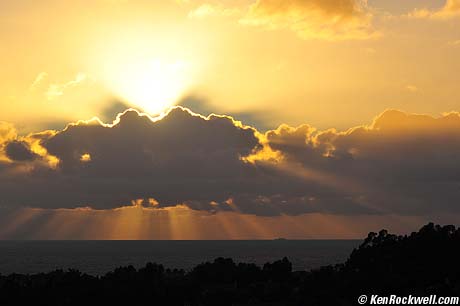
Sunset. 135mm DC on D3, normal ADR, f/11 at 1/500, ISO 200.
135mm f/2.0 DC on D3: Extraordinarily sharp and dead-on AF even at f/2.0, super-fast AF, zero lateral color, some axial color (seen on edges out-of focus highlights), no distortion and perfect bokeh.
The 135 DC also has a built-in hood that screws in place, unlike all the other Nikon teles whose built-in hoods simply slide in place.
28mm f/1.4 AF-D on D3: Better than expected, the 28/1.4 works as well as it always has on film. My fear was that digital today shows up more problems to anyone with a computer than anyone ever saw or cared about on film.
Luckily, the 28/1.4 is up to the D3. It's sharp and contrasty without veiling (spherical aberration) even at f/1.4. There is some light falloff (darkening in the corners) at f/1.4, much better at f/2 and gone by f/2.8.
It's sharp, contrasty and devoid of color fringes everywhere, even at f/1.4. It's softer in the last 2mm of the corners at f/1.4, improving to perfection by f/5.6, but that's never mattered since this is a lens for hand-held night photography, not test charts. Keeping the farthest last millimeter of corner sharp never matters at f/1.4 because they are never in focus with a live subject anyway. 99% of the image area is blazingly sharp, even at f/1.4 in most of the corners, is what makes this aspherical lens stand forward of every other fast Nikon lens.
For astronomical use, ignore the last couple of millimeters in the corners, or shoot the D3 in its 24 x 30mm mode. There is nothing even close to the level of performance of this lens; the 28mm f/2 AI-s is awful by comparison until stopped down to f/4.
AF is perfect on the D3: dead-on even at f/1.4.
There are no lateral or axial color fringes.
Unfortunately, this great lens was so expensive that no one bought them in the 1990s, so Nikon stopped making them, leaving us with the grossly inferior 35mm f/1.4 manual focus (introduced in 1969!) and 50mm f/1.4 AF-D today. These other lenses were fine decades ago, and fine today for normal photography, but nowhere close to the performance at f/1.4 as displayed by the 28mm f/1.4.
The 28mm f/1.4 uses an aspherical element to eliminate spherical aberration, while every other NIkon f/1.4 lens still uses ancient spherical technology. The other f/1.4 lenses show lower contrast, cause by residual spherical aberration, at f/1.4.
If you don't already have one, forget about it because used ones are overpriced today and waiting to take a fall whenever, if ever, Nikon introduces an AFS replacement. Auto and manual focus still require moving a switch on the 28/1.4.
Except maybe for the 58mm Noct manual focus which may be similar, there is no other lens ever made by Nikon which comes close to this for wide-angle, high speed performance.
I still need to re-write and update my 28mm f/1.4 review for the D3; you heard this information here first on this page. I also have heard reports of sample variation; I love my 28/1.4, but others haven't. To get the performance of which the 28/1.4 is capable requires a properly adjusted AF system and some practice.
When I say this is a great lens, I mean great for its crazy intended purpose of shooting at f/1.4. I got it used years ago for shooting hand-held nightscapes on ISO 50 Fuji Velvia. In daylight, I never use this lens; I much prefer any reasonable zoom, like the 24-120mm VR or 28-70mm f/3.5-4.5 AF-D, both still to be tested on the D3.
18mm f/2.8 AF-D on D3: Awful. I didn't like the 18mm AF when I tried it on film in 1999, and on the D3, it's still awful. Awful means the corners are fuzzy, one side is fuzzy, and even crazier, the distortion is atrocious.
I have no idea how it can be so bad, with all the advanced technology and high price Nikon threw at it, but the zooms and the 1980's 18mm f/3.5 AI-s and 1970's 18mm f/4 AI are better.
I thought I was the only one, but I've had bad performance with two samples, another friend just got one and returned it, and Bjørn didn't like it either. The AF 18mm f/2.8 also has the worst ghosting problem I've ever seen, and the HB-8 hood with which it came new is impossible to find unless you still have yours. If the sun is in the image, which it usually is with an ultrawide, you get a stream of small ghosts running all along the axis to and from the sun.
I still need to re-write and update my 18mm reviews for the D3; you heard this here first on this page.
14-24mm on D3: As expected, the 14-24mm is insanely good on the D3. I imagine a very polite Nikon product manager sitting in Japan with his middle finger raised to his competitors with this one. It does things no lens before has done. It is sharper wide-freaking-open at 14mm in the far corners than the fixed 14mm f/2.8 is stopped down at f/5.6! For sharpness, the 14-24mm is blazingly sharp and devoid of any coma or softness at every aperture, everywhere in the full film and FX Digital field. It's just nuts! Optically, if you're looking too close, it makes the other ultra-wides look like poo-poo. Of course if you're just taking pictures, any of the other lenses works fine, and usually take filters which the 14-24mm can't.
17-35mm f/2.8 AF-s on D3: Distortion is lower than 14-24mm at each lenses' widest end, but sharpness in the corner is much less at the wide end of the 17mm at f/2.8. This is as expected. If you want to shoot test charts, not be able to use grad and other filters and have to haul around a lens that weighs over two pounds, sure, get the 14-24mm, but for practical use, the 17-35mm is as good, smaller, takes filters, and has a more practical zoom range. The 17-35mm is almost as good at 24mm, and it's even sharper at 35mm where the 14-24mm can't even go. This again is looking in the far corners at large apertures (f/2.8 - 5.6); both are as good in the center and at small apertures.
14mm Shoot-out on D3:
If you're looking at 100% at f/2.8 in the corners, yes, the 14-24mm f/2.8 AF-S is superior. The 14-24mm at f/2.8 is sharper in the corners than the fixed 14mm f/2.8 AF-D is at f/5.6!
There is darkening in the corners with the 14mm at f/2.8 and f/4; there isn't with the 14-24mm even wide-open at f/2.8.
For most things, i.e., stopped down, the 14mm fixed is just as good as the zoom at 14mm.
The 14mm fixed has less distortion, although the simple curvature of the 14-24mm is easier to correct in Photoshop than the complex distortion of the 14mm.
Straight vertical lines running up the left or right side stay straight with the 14mm, but bug out with the 14-24mm.
The 14mm sees a very slightly wider view than the 14-24mm.
Would I haul around the bigger zoom lens? I don't know, going to lunch with my wife, the D3 and 14-24mm is such a pig I really wonder. The 14mm is much smaller; almost reasonable for carrying around all day.
I also ran the Canon 14mm (1992-2007 version, not the new 14mm II version) on the 5D. It is clearly inferior.
28-200mm G on D3:
This plastic lightweight works great if used properly. I just tried it, and it's made of the same magic stuff Nikon has used in its other recent crappy cheap lenses that just happen to have better performance than earlier lenses. The diminutive 28-200mm G works great if you want light and wide-ranged. I paid $160 for this lens used; for people with a D3 I suspect the 24-120mm VR is a better idea for a lightweight, do-all lens. I'll let you know.
most of what I've been shooting is parties. For that, the D3 is incredible, with the 50mm f/1.4 D lens, for use in no light. It's the first time I can shoot moving things without flash in available light, and not have to apologize for subject blur! The D3 and D300 also allow me to set gray-card (actually white-napkin) WB in crummy light, and make it look good! Earlier cameras like my D40 and D200 never gave the look I wanted in available light, often blinking "ng," while the D3 and D300 always return a "good" after shooting a napkin in crummy restaurant light. Not only does the camera say "good," the colors and results are great!
The 1976 28-45mm f/3.5 AI works great on the D3; too. It's sharp and has well controlled distortion at 28mm, and oddly is softer and more distorted at 45mm.
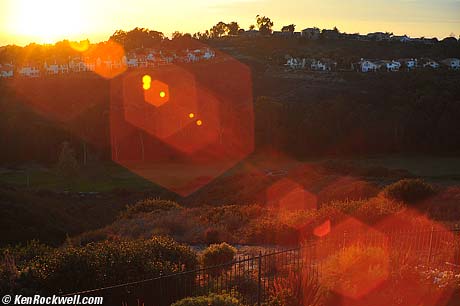
How bad it was! Ghosts everywhere!!! (D3, 43-86mm f/3.5 F at f/8)
43-86mm f/3.5 (original 9-element version) on D3: Pretty bad! This was the lens which was so bad that it single-handedly set the bad reputation all zooms have had to endure for the past 40 years. This version I just tried was made from 1963 - 1974. Mine is from about 1971.
Distortion, especially at 86mm, is hellacious, and it's pretty blurry most places except in the center. This said, in the hands of a good photographer it can make great images, but for testing, it's the reference for what is awful.
The one I tried had been factory AI converted, so this 1971 lens is perfectly compatible with Matrix metering, EXIF data and aperture-preferred automation on the D3.
75-150mm f/3.5 E on D3: Distortion seems very well controlled, and it seems sharp.
More later on the 75-150 E; what is weird is how I just realized that Nikon sort of forgot this lens in the "non-CPU lens data" menu. Even though the menus include 43mm and 86mm which were only found on the 43-86mm lens, all discontinued since 1974, the menus don't have 75mm (use 80mm) or 150mm (use 180mm)!
Nikon includes 86mm as well as 85mm in the menus, just for history's sake. What a slap in the face to the 75-150 E to be forgotten. Nikon does include 100mm as well as 105mm to remember the 100mm f/2.8 E which is a great performer on the D3. The menus include 6mm and 13mm, lenses of which Nikon only made about 500 and 200 copies, respectively, but skip 75mm and 150mm, of which Nikon made 250,000 lenses up through 1985!
20mm f/3.5 UD on D3: The old 20mm f/3.5 UD (72mm filter, 1967 - 1974) seems to work quite well, about as well as newer lenses. Of course the one I tried was factory AI converted for full compatibility with modern cameras, just as the 43-86mm was converted. Nikon stopped doing AI conversions decades ago; today people have to look elsewhere.
Nikon 300mm f/4 AF on D3: Works great, at least on a first try. No lateral color fringes. Contrasty even at f/4. Doesn't get soft in corners, even at f/4. The AF of the D3 is so fast that AF is fast enough. One's biggest barrier to sharpness is the lack of VR; results at 1/250 and slower often are blurred from hand-holding, although I can pull out sharp shots from a sequence even at 1/30.
50mm f/1.4 AF-D on D3: The 50mm f/1.4 D works great on the D3: AF is fast and sure, even in dim light like this. The 50mm f/1.4 loses a little local contrast at f/1.4 due to the spherical aberration inherent in its 1950s-based optical design, but so what: the Zeiss 50mm f/1.4 has the same design problems but won't autofocus at all! The 58mm Noct might have better local contrast at f/1.4, but it doesn't autofocus, and there's no way I could focus manually on my kid who was wiggling in and out the whole time.
For under $300, the 50mm f/1.4 AF-D is the way to get low-light shots, not buying a fancier camera that shoots at crazy high ISOs. If I was using a $1,700 f/2.8 zoom, I'd have needed noisy ISO 12,500 or blurry 1/30 to do this same thing.
Sure, the 50/1.8 AF-D (and 50mm f/1.8 E manual focus) is as good at normal apertures, but for low-light use on a $5,000 camera like the D3, of course get the 50mm f/1.4.
DX lenses shot on FX: (Caution: this is playing in God's domain, and we all know what happened to Dr. Frankenstein.) Heh heh, it's trivial to defeat the auto DX crop switch on the D3 and shoot DX lenses full-frame. Lo and behold, if you already own the 12-24mm DX, as I reported on film, it works fairly well on full-frame from 17 - 24mm. Pull the filter at 17mm otherwise it vignettes, and it vignettes set wider even without the filter.
If you don't mind the limited range and already own the 12-24mm, it will be about as sharp as the 17-35mm f/2.8 AF-s and 18-35mm AF-D lenses on the D3. No, nothing is as sharp as the 14-24mm if you're looking too hard.
Most other DX lenses don't have enough utility or application to bother with this.
PLUG
I support my growing family through this website.
If you find this as helpful as a book you might have had to buy or a workshop you may have had to take, feel free to help me continue helping everyone.
If you've gotten your gear through one of my links or helped otherwise, you're family. It's great people like you who allow me to keep adding to this site full-time. Thanks!
If you haven't helped yet, please do, and consider helping me with a gift of $5.00.
It also helps me keep adding to this site when you get your goodies through these links to Adorama, Amazon, B&H, Ritz, and J&R. I use them and recommend them all personally.
Thanks for reading!
Ken






